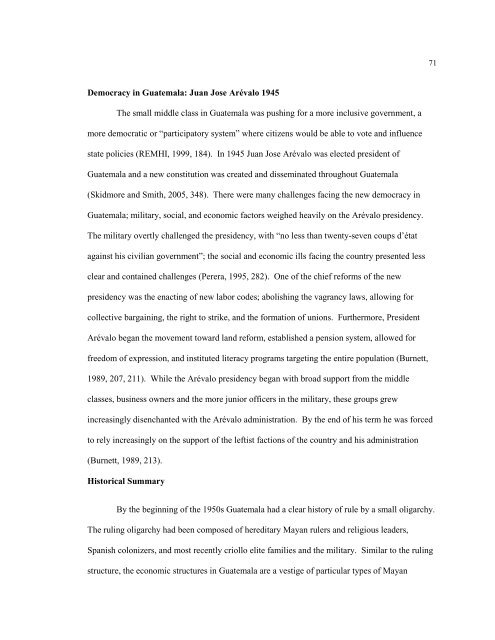Complete Thesis_double spaced abstract.pdf
Complete Thesis_double spaced abstract.pdf
Complete Thesis_double spaced abstract.pdf
Create successful ePaper yourself
Turn your PDF publications into a flip-book with our unique Google optimized e-Paper software.
Democracy in Guatemala: Juan Jose Arévalo 1945<br />
The small middle class in Guatemala was pushing for a more inclusive government, a<br />
more democratic or “participatory system” where citizens would be able to vote and influence<br />
state policies (REMHI, 1999, 184). In 1945 Juan Jose Arévalo was elected president of<br />
Guatemala and a new constitution was created and disseminated throughout Guatemala<br />
(Skidmore and Smith, 2005, 348). There were many challenges facing the new democracy in<br />
Guatemala; military, social, and economic factors weighed heavily on the Arévalo presidency.<br />
The military overtly challenged the presidency, with “no less than twenty-seven coups d’état<br />
against his civilian government”; the social and economic ills facing the country presented less<br />
clear and contained challenges (Perera, 1995, 282). One of the chief reforms of the new<br />
presidency was the enacting of new labor codes; abolishing the vagrancy laws, allowing for<br />
collective bargaining, the right to strike, and the formation of unions. Furthermore, President<br />
Arévalo began the movement toward land reform, established a pension system, allowed for<br />
freedom of expression, and instituted literacy programs targeting the entire population (Burnett,<br />
1989, 207, 211). While the Arévalo presidency began with broad support from the middle<br />
classes, business owners and the more junior officers in the military, these groups grew<br />
increasingly disenchanted with the Arévalo administration. By the end of his term he was forced<br />
to rely increasingly on the support of the leftist factions of the country and his administration<br />
(Burnett, 1989, 213).<br />
Historical Summary<br />
By the beginning of the 1950s Guatemala had a clear history of rule by a small oligarchy.<br />
The ruling oligarchy had been composed of hereditary Mayan rulers and religious leaders,<br />
Spanish colonizers, and most recently criollo elite families and the military. Similar to the ruling<br />
structure, the economic structures in Guatemala are a vestige of particular types of Mayan<br />
71














![Completed Thesis to Grad Studies[Final3].pdf](https://img.yumpu.com/17538645/1/190x245/completed-thesis-to-grad-studiesfinal3pdf.jpg?quality=85)
